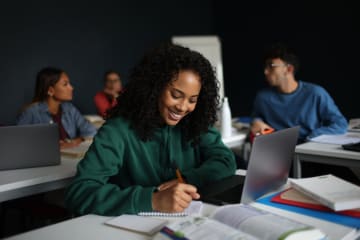Teaching Tuesday: Restorative Practices for Educators

Teachers do so much more than just teach. As teachers we create classrooms to support students academically, as well as socially and emotionally, in the school and the larger classroom community. Restorative practices are an effective way for us to hold students to high expectations, teach students how to process emotions and the choices they make, along with creating strong classroom communities.
Created by the International Institute of Restorative Practices (IIRP), restorative practices are conversation-focused strategies for preventing poor student choices or misconduct and developing strong relationships. Strategies include holding whole class, small group and one-on-one conversations with students. In doing this, teachers promote making positive choices, reflecting on actions taken by students and proactively building strong communities.
Restorative Practices that Benefit Classroom and School Communities
The purpose of restorative practices is to have discussions with students about misconduct and then restore the classroom community and welcome the student back so learning can continue. To do so, IIRP has created three types of practices:
- Circles
- Group Conferences
- One-on-One Chats
When classrooms and school communities implement restorative practices, the positive effects are plentiful. Students are also able to build strong relationships with their peers and teachers that support their emotional and social growth.
Circles
Circles, as a strategy for implementing restorative practices, occur as a whole class on a weekly basis. The purpose of circles is to develop and maintain class relationships, while teaching strategies for common social and emotional stressors students may face in and out of the classroom. Circles can be both preventative (building social and emotional strategies) and responsive (responding to a recent incident of misconduct).
Within circles, the teacher places the class in a circle and establishes a talking stick. This allows students to see one another and have a routine for sharing their ideas in a respectful manner. Circles can consist of asking students to share how they are feeling about a recent community or class event, or share their ideas for how they would respond to a scenario. Circles are also a great time to have students participate in team building activities that increase the strength of the overall classroom community.
Group Conferences
Group conferences, as another strategy, are a time to repair harm and restore relationships between students in response to an incident. This is a time to gather the students and discuss the incident and make plans to repair the harm done. After an incident, the teacher or facilitator informs the victim(s) and offender(s) that a group conference will occur.
The time before the conference allows the students to both reflect on the event and gather their thoughts. During the conference, the facilitator meets with both parties and establishes the purpose of the conference to repair harm. The facilitator then moderates a discussion between parties following a script that offers questions to ask the group. The victim is given time to share the details of the event and the resulting feelings they have. The offender listens, shares their feelings both during and after the event, and a plan is made to make amends. Here's a script to follow during a group conference.
One-on-One Chats
A third strategy, the one-on-one chat, occurs between the teacher and the student as a response to classroom misconduct. After an incident of student misconduct, the teacher asks the student to complete a self-reflection either in a cool down space in the classroom or in another location. This reflection can be done either through writing, drawing, or picture identification to reflect on what happened in the classroom, how the student was feeling at the time, how their classroom community is affected by the student’s choice, and what they will do next time.
This reflection time allows the student to meet with the teacher having calmed down and prepared to answer the questions the teacher will ask during their chat. After the chat, the teacher should restore their relationship with the student in a positive manner and then welcome them back into the classroom for a fresh start. Questions to ask or statements to make during a one-on-one chat can be found here.
The benefits of implementing restorative practices in the classroom are endless. Restorative practices were developed to address student misconduct but to truly focus on preventative measures and developing strong relationships. Through restorative practices, educators and school communities are able to hold students to high expectations. Administration through restorative practices can also communicate that misconduct will not result in exclusion but restoring relationships and repairing harm while returning students to the classroom community. This results in the classroom to be remained focused on learning.
Want more? Check out all of the articles from Teaching Tuesday and return each week for a new post. Learn more about Grand Canyon University's College of Education and our degree programs and join in our efforts to elevate the education profession.
The views and opinions expressed in this article are those of the author’s and do not necessarily reflect the official policy or position of Grand Canyon University. Any sources cited were accurate as of the publish date.


